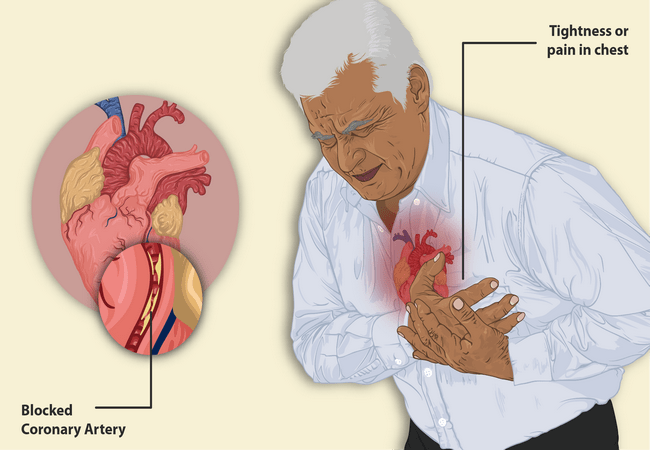Definition of Angina Pectoris:
Angina pectoris is a complex of ischaemic heart disease characterized by paroxysmal & usually recurrent attacks of sub sternal or precordial chest discomfort caused by transient (15 seconds to 15 minutes) myocardial ischaemia.

Types of Angina Pectoris:
1. Stable/ typical classical exertional:
It occurs due to reduction of coronary perfusion by stenosing coronary atherosclerosis to increased myocardial demand, eg. during physical activity, emotional excitement. It is usually relieved by rest or nitroglycerine.
2. Unstable/ crescendo/ pre-infarctional angina:
It occurs with progressively increasing frequency with less effort or at rest. Unstable angina usually occurs due to rupture, fissuring or ulceration of an atherosclerotic plaque with mural thrombosis.
3. Variant/ Prinzmetal’s angina:
This pattern occurs at rest due to coronary spasm. The patient may have no coronary atherosclerosis.
4. Decubitus angina/ Nocturnal angina:
Increased venous return produced by lying down in pulmonary congestion & pulmonary oedema.
Nursing Management of Angina Pectoris:
Nursing Assessment In assessing the patient with angina, the nurse may ask regarding the following:
- Location of pain,
- Characteristics of pain,
- Health history,
- Pain scale,
- Onset of pain,
- Cause of pain,
- Measures that relieve pain,
- Other symptoms that occur with pain.
Nursing Diagnosis of Angina Pectoris:
- Based on the assessment data, major nursing diagnosis may include:
- Ineffective cardiac tissue perfusion secondary to CAD as evidenced by chest pain or other prodromal symptoms.
- Death anxiety related to cardiac symptoms.
- Deficient knowledge about the underlying disease and methods for avoiding complication. Noncompliance, ineffective management of therapeutic regimen related to failure to accept necessary lifestyle changes.
Nursing Care Planning and Goals for Angina Pectoris:
Major patient goals include:
- Immediate and appropriate treatment when angina occurs.
- Prevention of angina.
- Reduction of anxiety.
- Awareness of the disease process and understanding of the prescribed care.
- Adherence to the self-care program.
- Absence of complications.
Nursing Interventions for Angina Pectoris:
Nursing interventions for a patient with angina pectoris include:
Treating angina:
The nurse should instruct the patient to stop all activities and sit or rest in bed in a semi-Fowler’s position when they experience angina, and administer nitroglycerin sublingually.
Reducing anxiety:
Exploring implications that the diagnosis has for the patient and providing information about the illness, its treatment, and methods of preventing its progression are important nursing interventions.
Preventing Pain:
The nurse reviews the assessment findings, identifies the level of activity that causes the patient’s pain, and plans the patient’s activities accordingly.
Decreasing oxygen demand:
Balancing activity and rest is an important aspect of the educational plan for the patient and family.
Evaluation:
The expected patient outcomes are:
- Reported pain is relieved promptly.
- Reported decrease in anxiety.
- Understood ways to avoid complications and is free of complications.
- Adhered to self-care program.
Discharge and Home Care Guidelines for Angina Pectoris:
- Reduce anginal attacks. Activities should be planned to minimize the occurrence of angina episodes.
- Follow-up monitoring. The patient may need reminders about follow-up monitoring, including periodic blood laboratory testing and ECGs.
- The home care nurse may monitor the patient’s adherence to dietary restrictions and to prescribed antianginal medications.

Maria Khatun Mona is a Founder and Editor of Nursing Exercise Blog. She is a Nursing and Midwifery Expert. Currently she is working as a Registered Nurse at Evercare Hospital, Dhaka, Bangladesh. She has great passion in writing different articles on Nursing and Midwifery. Mail her at “maria.mona023@gmail.com”
